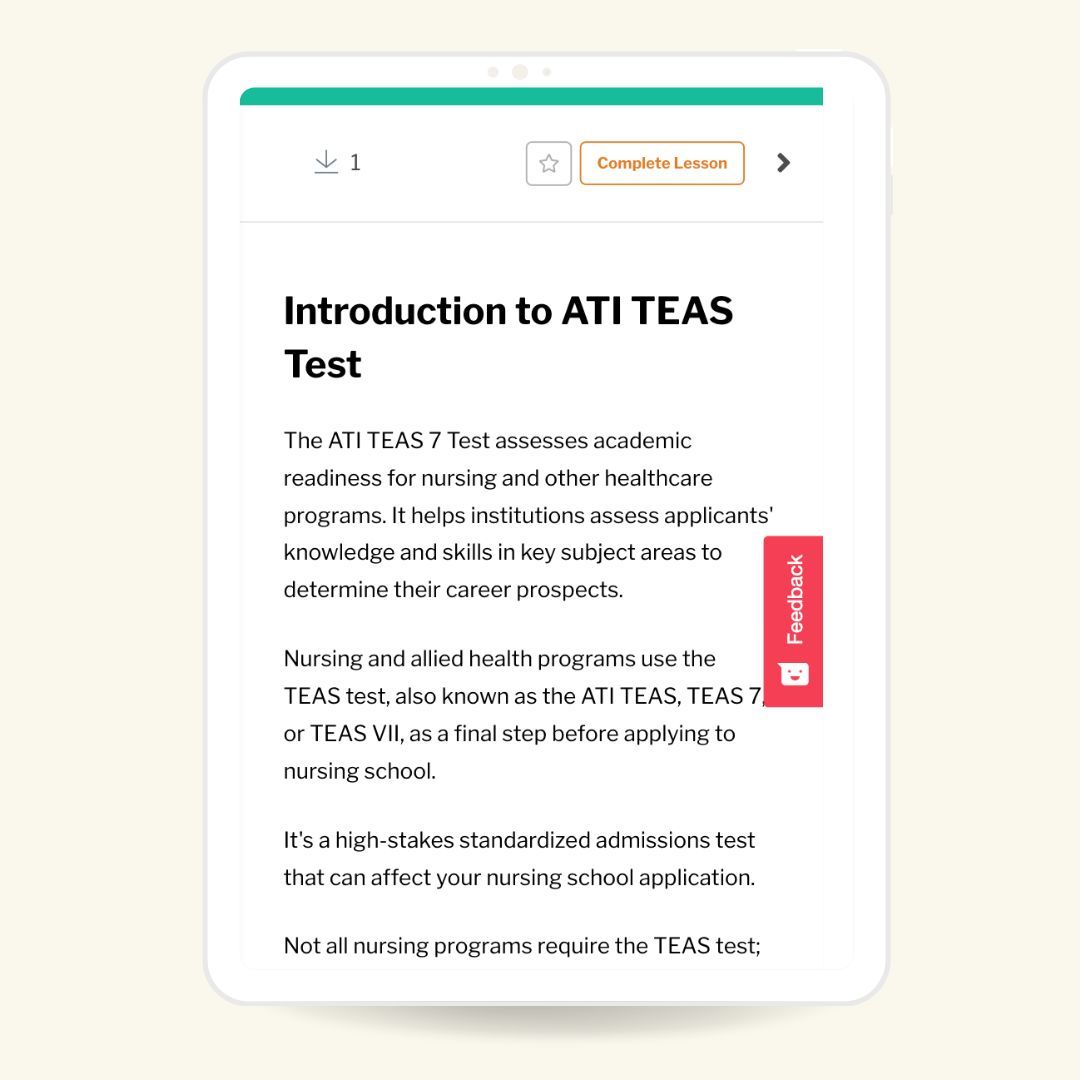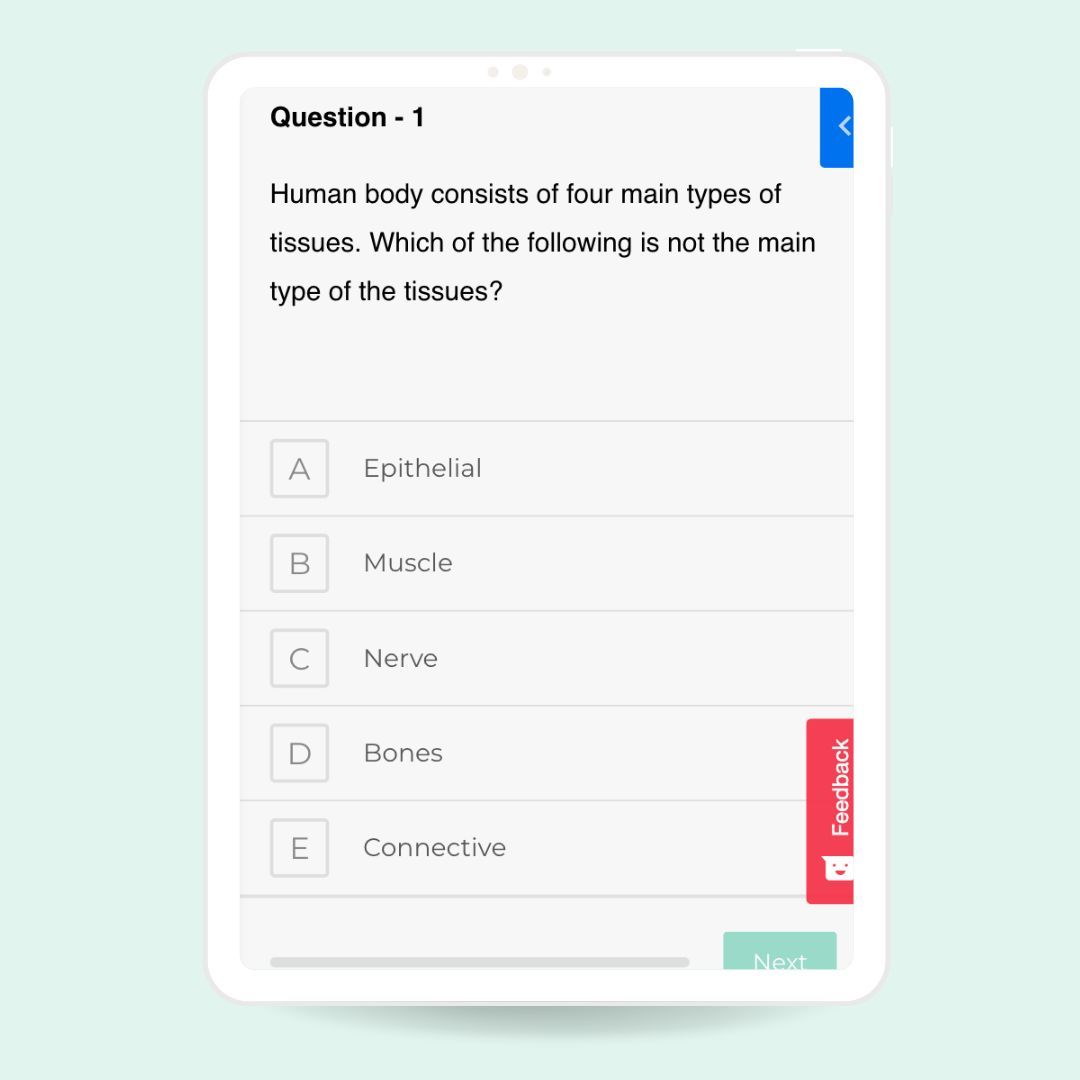The ATI Test of Essential Academic Skills (TEAS) is divided into four main categories, each of which tests different fundamental skills required for success in a nursing program. The main test categories are explained below with examples.
Reading
The Reading section assesses reading comprehension, analysis, and interpretation. Passages may be followed by questions about the main idea, theme, context, or word meaning.
Sample Questions:
Passage: Max was always fond of adventures. He spent his days exploring the nearby woods, often coming home with pockets full of interesting artifacts. He loved the excitement of discovering something new and believed that there were always things waiting to be found, if only one looked closely.
Question 1:
What is the main theme of the passage?
A. Max's love for collecting artifacts.
B. Max's curiosity and love for adventure.
C. The beauty of the nearby woods.
D. The excitement of discovery.
Correct Answer: B
Explanation: The passage emphasizes Max's love of exploration and adventure. He collects artifacts and explores the woods, but these are just details to illustrate Max's adventurous spirit and curiosity.
Question 2:
In the context of the passage, what does the word 'artifacts' likely refer to?
A. Ancient objects from a past civilization.
B. Items of historical or archaeological interest.
C. Natural objects such as rocks and leaves.
D. Interesting objects that Max finds during his exploration.
Correct Answer: D.
Explanation: In the context of the passage, "artifacts" do not have to be ancient or important in history. They can just be interesting things that Max finds on his adventures in the woods and keeps. So, option D is the best choice.
Mathematics
The ATI TEAS 7 Math section covers basic calculations, algebra, data interpretation, and measurement. It assesses how well a student can solve math problems, such as those with whole numbers, fractions, percentages, and simple algebraic equations.
Mathematics Word Problems
Math Word Problem questions are stated in the form of statements and candidates are asked to solve them and choose the correct answer from provided options.
Sample Question:
Simon bought eight bananas for $0.96. How much would six bananas cost?
A. $0.64
B. $0.70
C. $0.72
D. $0.80
Correct Answer: C
Explanation: $0.96 is the price of 8 bananas so the price of 1 banana will be $0.12 and hence 6 bananas will cost $0.72.
Averages
These questions must be calculated using the mean's calculation formula because they relate to group data.
Sample Question:
6 students in a class scored 25, 23, 20, 16, 18 and 24 marks in a test out of 25. What is the average score of these students?
A. 20
B. 21
C. 23
D. 24
Correct Answer: B
Explanation: Find the sum of all scores will be added and then divided by the total number of students.
25 + 23 + 20 + 16 + 18 + 24 = 126
The average score of these students = 126 / 6 = 21
Hence correct answer is 21.
Percentages
Candidates are required to carefully comprehend the statement before calculating the percentage in accordance with the given scenario.
Example:
A basketball team played 120 games and won 96 of them. What percentage of games did they lose?
A. 30%
B. 40%
C. 20%
D. 10%
Correct Answer: C
Explanation: Firstly, let's find the number of games they lost.
120 – 96 = 24.
To find the percentage, we divide 24 by 120, multiply by 100
= 24/120 * 100 = 20%
Thus the total percent of matches they lost is 20%.
Number sequences
The candidates are given a series of number sequences and asked to identify the correct pattern according to the given scenario.
Sample Question:
What number comes next in this sequence?
44, 53, 72, 65, 82, 91, 21, ??
A. 12
B. 30
C. 14
D. 84
Correct Answer: B
Explanation: 9 is added after several sequences hence 30 is the correct answer.
Algebra
Solve for x: 3x – 7 = 20
A. x = 5
B. x = 9
C. x = 6
D. x = 7
Correct Answer: B
Explanation: To solve the equation, add 7 to both sides to isolate the term with x on one side of the equation. It becomes 3x = 27.
Then, divide both sides by 3 to solve for x. So, x = 9.
Question 2:
If 2y – 3 = 7, what is the value of y?
A. y = 2
B. y = 3
C. y = 5
D. y = 7
Correct Answer: C.
Explanation: To solve for y, you add 3 to both sides of the equation to get 2y = 10. Then, you divide both sides by 2, which gives y = 5.
English and Language Usage
This section tests your grammar, vocabulary, punctuation, and sentence structure. It assesses your understanding of the English language and their ability to communicate effectively.
Sample Question 1:
Medicine is to illness as the law is to -------
A. Anarchy
B. Discipline
C. Treason
D. Etiquette
Correct Answer: B
Explanation: Medicine is used to cure the illness hence the law is used for maintaining the discipline.
Sample Question 2:
What is the antonym of ‘narrow’?
A. Long
B. Straight
C. Curvy
D. Broad
Correct Answer: D
Explanation: The antonym of narrow is broad.
Sample Question 3:
Which word does not have a similar meaning to – 'outcome?'
A. Affect
B. Result
C. Upshot
D. Effect
Correct Answer: B
Explanation: The similar meaning of outcome is result.
Sample Question 4:
Choose the grammatically correct sentence:
A. She don't like spinach.
B. She doesn't likes spinach.
C. She doesn't like spinach.
D. She do not like spinach.
Correct Answer: C.
Explanation: The correct negative form of 'like' in the third-person singular is 'doesn't like', so option C is the correct sentence.
Sample Question 5:
Choose the grammatically correct sentence:
A. The cats chases the mouse.
B. The cats chase the mouse.
C. The cats chasing the mouse.
D. The cats is chasing the mouse.
Correct Answer: B.
Explanation: When the subject is plural, the verb should also be in its plural form. So, 'The cats chase' is the correct sentence structure. Hence, option B is correct.
Science
This section focuses on basic biological sciences, physical sciences, human body science, and scientific reasoning. Topics often include human anatomy and physiology, biology, chemistry, and the scientific reasoning.
Sample question 1:
What is the role of the sinoatrial (SA) node in the cardiovascular system, and how does it contribute to the regulation of heart rate?
A. The SA node initiates the electrical impulses that coordinate the contraction of the heart muscles.
B. The SA node regulates the oxygenation levels in the blood.
C. The SA node controls the dilation and constriction of blood vessels.
D. The SA node is responsible for the production of red blood cells in the bone marrow.
Correct Answer: A
Explanation: The SA node, also known as the pacemaker of the heart, generates electrical signals that initiate each heartbeat and coordinate the contraction of the heart muscles. Option A correctly identifies the role of the SA node in regulating heart rate.
Sample Question 2:
How does the structure of a capillary facilitate the exchange of gases, nutrients, and waste products between the blood and body tissues?
A. Capillaries have thick walls and a narrow lumen, allowing for rapid blood flow.
B. Capillaries have one-way valves that prevent the backflow of blood.
C. Capillaries have a large surface area and thin walls, enabling efficient exchange of substances.
D. Capillaries are surrounded by smooth muscles that regulate their diameter.
Correct Answer: C
Explanation: Option C accurately describes the structural features of capillaries that contribute to the exchange of substances. Capillaries have a large surface area and thin walls, which allow for the efficient diffusion of gases, nutrients, and waste products between the blood and body tissues.
Sample Question 3:
Which organ in the digestive system is responsible for the production of bile and plays a crucial role in the digestion and absorption of fats?
A. Stomach
B. Small intestine
C. Liver
D. Gallbladder
Correct Answer: D
Explanation: The liver is responsible for the production of bile, which plays a crucial role in the digestion and absorption of fats. Bile is stored and concentrated in the gallbladder and released into the small intestine when needed.
Sample Question 4:
Which of the following enzymes is responsible for the breakdown of carbohydrates in the mouth?
A. Amylase
B. Lipase
C. Pepsin
D. Trypsin
Correct Answer A
Explanation: Amylase is the enzyme responsible for the breakdown of carbohydrates in the mouth. It helps to break down complex carbohydrates into simpler sugars, initiating the digestion of carbohydrates.
Sample Question 5:
What is the primary function of the villi in the small intestine?
A. Absorption of nutrients
B. Production of digestive enzymes
C. Storage of bile
D. Secretion of gastric juices
Correct Answer: A
Explanation: The primary function of the villi in the small intestine is the absorption of nutrients. The villi are small finger-like projections that increase the surface area of the small intestine, allowing for efficient absorption of nutrients into the bloodstream.







